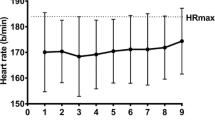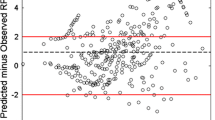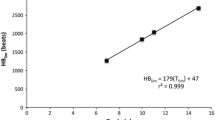Summary
The purpose of this study was to determine the effect of training on the rating of perceived exertion (RPE) at the ventilatory threshold. College students were assigned to either training (n=17) or control (n=10) groups. Trainers completed 18 interval training sessions (five × 5 min cycling at 90–100%\(\dot V_{{\text{O}}_{{\text{2 max}}} } \)) and 8 continuous training sessions (40 min running or cycling) in 6 weeks. Pre- and post-training, cardiorespiratory, metabolic, and perceptual variables were measured at the ventilatory threshold during graded exercise tests on a cycle ergometer. Ventilatory threshold was that point above which\(\dot V_{\text{E}} \cdot \dot V_{{\text{O}}_{\text{2}} } ^{ - 1} \) increased abruptly relative to work rate. Post-training means of trained and control subjects were compared using analysis of covariance, with pre-training values as covariates. Following training, the adjusted means for the trained subjects were significantly greater (p<0.05) than for controls for\(\dot V_{{\text{O}}_{{\text{2 max}}} } \) (6%), and for work rate (20%),\(\dot V_{{\text{O}}_{\text{2}} } \) (23%), and %\(\dot V_{{\text{O}}_{{\text{2 max}}} } \) (13%) at the ventilatory threshold. However, adjusted means for RPE at the ventilatory threshold were not significantly different (2%). Both before and after training, exercise at the ventilatory threshold was perceived as ‘somewhat hard’ to ‘hard’ (RPE=13–15) by both groups. The relationship between RPE and %\(\dot V_{{\text{O}}_{{\text{2 max}}} } \) was altered by training, with trained subjects having a lower RPE at a given %\(\dot V_{{\text{O}}_{{\text{2 max}}} } \). It is concluded that RPE at the ventilatory threshold is not affected by training, despite that after training the ventilatory threshold occurs at a higher work rate and is associated with higher absolute and relative metabolic and cardiorespiratory demands.
Similar content being viewed by others
References
Bar-Or O, Skinner JS, Buskirk ER, Borg G (1972) Physiological and perceptual indicators of stress in 41- to 60-year-old men who vary in conditioning level and in body fatness. Med Sci Sports 4:96–100
Bellew KM, Burke EJ, Jensen BE (1983) Ratings of perceived exertion at anaerobic threshold in males and females (Abstr). Abstracts of research papers AAHPERD, Reston, Virginia, p 10
Birk T, Jeffery K, Birk C, Theurer L, Johnson G (1985) Relationship of perceived exertion and heart rate during exercise testing and training in cardiac patients (Abstr). Med Sci Sports Exerc 17:199
Borg G (1974) The perception of physical performance. In: Shephard RJ (ed) Frontiers of fitness. Charles C Thomas, Springfield, Illinois, pp 280–294
Borg G (1982) Psychophysical bases of perceived exertion. Med Sci Sports Exerc 14:377–381
Brehm BA, Gutin B, Alejandro D (1985) Prescription of exercise intensity by ventilatory threshold and percent aerobic capacity (Abstr). Med Sci Sports Exerc 17:288
Caiozzo VJ, Davis JA, Ellis JL, Azus JL, Vandagriff R, Prietto CA, McMaster WC (1982) A comparison of gas exchange indices used to detect the anaerobic threshold. J Appl Physiol: Respirat Environ Exercise Physiol 53:1184–1189
Davies CTM, Sargeant AJ (1979) The effects of atropine and practolol on the perception of exertion during treadmill exercise. Ergonomics 22:1141–1146
Davis JA (1985) Anaerobic threshold: review of the concept and directions for future research. Med Sci Sports Exerc 17:6–18
Davis JA, Frank MH, Whipp BJ, Wasserman K (1979) Anaerobic threshold alteration caused by endurance training in middle-aged men. J Appl Physiol 46:1039–1046
Davis JA, Vodak P, Wilmore JH, Vodak J, Kurtz P (1976) Anaerobic threshold and maximal aerobic power for three modes of exercise. J Appl Physiol 41:544–550
DeMello JJ, Cureton KJ, Boineau R, Singh MM (1985) Effects of state of training and gender on ratings of perceived exertion at the lactate threshold (Abstr). Med Sci Sports Exerc 17:198
Docktor R, Sharkey BJ (1971) Note on some physiological and subjective reactions to exercise and training. Percep Mot Skills 32:233–234
Dressendorfer RH, Smith JL, Merrill J, Catlin MJ, Carmichael F, Goodfliesh R, Borysyk L, Gordon S, Timmis GC (1981) Quantification of exercise responses at anaerobic threshold in healthy men: relation to prescribed training heart rates (Abstr). Med Sci Sports Exerc 13:79
Ekblom B, Goldbarg AN (1971) The influence of training and other factors on the subjective rating of perceived exertion. Acta Physiol Scand 83:399–406
Gladden LB, Yates JW, Stremel RW, Stamford BA (1985) Gas exchange and lactate anaerobic thresholds: inter- and intra-evaluator agreement. J Appl Physiol 58:2082–2089
Hickson RC, Bomze HA, Holloszy JO (1977) Linear increase in aerobic power induced by a strenuous program of endurance exercise. J Appl Physiol: Respirat Environ Exercise Physiol 42:372–376
Hill DW, Cureton KJ, Grisham SC, Collins MA (1985) Perceived exertion at different times of day (Abstr). Abstr of the Ann Meeting of the Can Assoc of Sport Sci 18:13
Katch V, Weltman A, Sady S, Freedson P (1978) Validity of the relative percent concept for equating training intensity. Eur J Appl Physiol 39:219–227
LaFontaine TB, Londeree BR, Spath WK (1981) The maximal steady state versus selected running events. Med Sci Sports Exerc 13:190–193
Mihevic PM (1981) Sensory cues for perceived exertion: a review. Med Sci Sports Exerc 13:150–163
Mihevic PM (1983) Cardiovascular fitness and the psychophysics of perceived exertion. Res Q Exerc Sport 54:239–246
Morgan WP, Hirta K, Weitz GA, Balke B (1976) Hypnotic pertubation of perceived exertion: ventilatory consequences. Am J Clin Hypn 189:182–190
Morgan WP, Pollock ML (1977) Physiologic characterization of the elite distance runner. Ann NY Acad Sci 301:382–403
Murray R, Dilorio J, Clark R, Seifert J, Mills K, Bainbridge C (1985) A comparison of two non-invasive methods of determining the ventilatory threshold (Abstr). Med Sci Sports Exerc 17:249
Nagle FJ, Morgan WP, Hellickson RO, Serfass RC, Alexander JF (1975) Spotting success traits in Olympic contenders. Physic Sports Med 12:31–34
Noble BJ (1982) Clinical applications of perceived exertion. Med Sci Sports Exerc 14:406–411
Pandolf KB (1982) Differentiated ratings of perceived exertion during physical exercise. Med Sci Sports Exerc 14:397–405
Pollock ML (1973) The quantification of endurance training programs. In: Wilmore JH (ed) Exerc and sports sci rev. Academic Press, New York, NY, pp 155–188
Powers SK, Dodd S, Deason R, Byrd R, McKnight T (1983) Ventilatory threshold, running economy and distance running performance. Res Q Exerc Sport 54:179–182
Purvis JW (1980) Effect of training on the ratings of perceived exertion at anaerobic threshold. Unpublished doctoral dissertation, University of Georgia, Athens, Georgia, USA
Purvis JW, Cureton KJ (1981) Ratings of perceived exertion at the anaerobic threshold. Ergonomics 24:295–300
Ready AE, Quinney HA (1982) Alterations in anaerobic threshold as the result of endurance training and detraining. Med Sci Sports Exerc 14:292–296
Robertson RJ, Gillespie RL, McCarthy J, Rose KD (1979) Difing dynamic exercise. Med Sci Sports Exerc 14:390–396
Robertson RJ, Gillespie RL, McCarthy J, Rose KD (1979) Differentiated perceptions of exertion: part II. Relationship to local and central physiological responses. Percept Mot Skills 49:691–697
Sidney KH, Shephard RJ (1977) Perception of effort in the elderly: effects of aging, mode of exercise and physical training. Percept Mot Skills 44:999–1010
Simon J, Gutin JL, Young J, Blood DK, Case RB (1983) Perceived exertion in highly-trained and untrained cyclists at anaerobic threshold (Abstr). Med Sci Sports Exerc 15:121
Skinner JS, Borg G, Buskirk ER (1969) Physiological and perceptual reactions to exertion of young men differing in activity and body size. In: BD Franks (ed) Exercise and fitness. The Athletic Institute, Chicago, Illinois, 53–66
Smutok MA, Skrinar GS, Pandolf KB (1980) Exercise intensity: subjective regulation by perceived exertion. Arch Physiol Med Rehabil 61:569–574
Sullivan MJ, Myers J, Kraemer M, Pewen W, Atwood JE, Froelicher VF (1986) Effect of beta blockade on perceived exertion in patients with atrial fibrillation (Abstr). Med Sci Sports Exerc [Suppl 18] S39
Wasserman K (1984) The anaerobic threshold measurement to evaluate exercise performance. Am Rev Respir Dis [Suppl] 129:S35-S40
Wilmore JH, Costill DL (1974) Semiautomated systems approach to the assessment of oxygen uptake during exercise. J Appl Physiol 36:618–620
Author information
Authors and Affiliations
Rights and permissions
About this article
Cite this article
Hill, D.W., Cureton, K.J., Grisham, S.C. et al. Effect of training on the rating of perceived exertion at the ventilatory threshold. Europ. J. Appl. Physiol. 56, 206–211 (1987). https://doi.org/10.1007/BF00640645
Accepted:
Issue Date:
DOI: https://doi.org/10.1007/BF00640645




